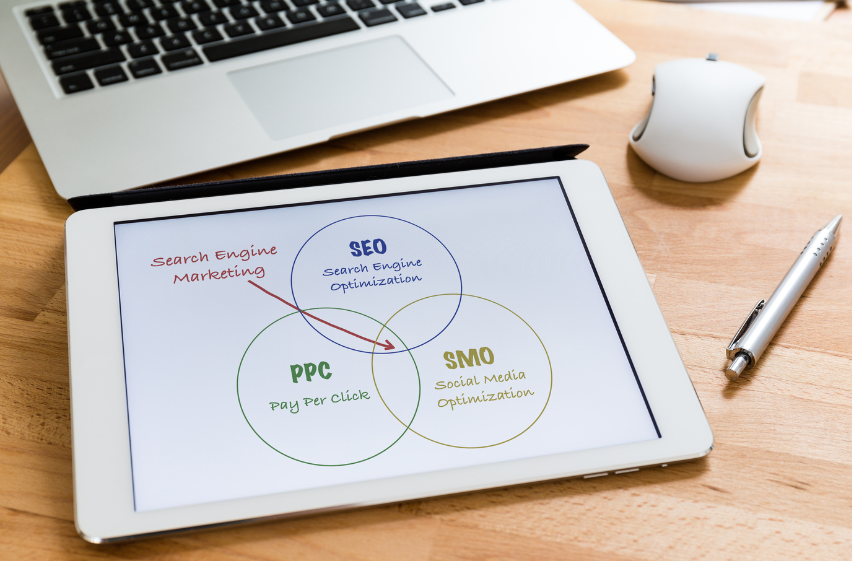SEO vs. PPC
Digital marketing is an essential tool for businesses looking to grow online. Two of the most popular strategies used to boost a business’s online presence are Search Engine Optimization (SEO) and Pay-Per-Click (PPC) advertising. Both methods aim to increase visibility, attract customers, and drive sales, but they operate differently.
In this blog post, we’ll explore what SEO and PPC are and how they work, and help you decide which strategy is right for your business.
What is SEO?
SEO (Search Engine Optimization) is the process of improving your website to rank higher in search engine results pages (SERPs). The goal is to increase organic traffic—people finding your site without paid advertisements.
Key Elements of SEO:
- On-page SEO: This involves optimizing the content on your website. It includes using relevant keywords, optimizing images, and ensuring fast load times.
- Off-page SEO: This focuses on building the reputation and authority of your site through backlinks from other reputable websites.
- Technical SEO: This includes aspects such as website structure, mobile-friendliness, and improving the site’s security (like HTTPS).
- Content: High-quality, relevant content is crucial for SEO. It attracts visitors and helps search engines understand what your website is about.
What is PPC?
PPC (Pay-Per-Click) is a form of online advertising where businesses pay for each click on their ads. These ads typically appear at the top of search results or on social media platforms like Google Ads or Facebook Ads.
Key Elements of PPC:
- Ad copy: Creating compelling and relevant ad content to attract clicks.
- Targeting: PPC allows businesses to target specific keywords, demographics, locations, and interests.
- Budget management: You set a budget, and you’re only charged when someone clicks on your ad.
- Landing pages: The pages where users land after clicking on your ad should be optimized to convert visitors into customers.
SEO vs. PPC: A Breakdown
1. Cost
- SEO: SEO is technically free, but it requires an investment of time and effort. You’ll need to create quality content, optimize your site, and hire an SEO expert. It’s a long-term investment that doesn’t provide immediate results but can lead to sustainable traffic over time.
- PPC: PPC requires a direct financial investment. You’ll pay for every click, and the cost can vary depending on the competitiveness of your chosen keywords. PPC can quickly bring traffic, but once you stop paying, the traffic stops.
2. Speed of Results
- SEO: SEO is a long-term strategy. It may take several months for efforts to show results, but once you start ranking higher, the organic traffic can be consistent.
- PPC: PPC offers instant results. As soon as your ads go live, you can start receiving traffic. This is beneficial if you need quick results, such as for a product launch or limited-time promotion.
3. Sustainability
- SEO: SEO is more sustainable in the long run. Once you rank high for certain keywords, you can maintain that ranking with regular updates and content creation without additional costs.
- PPC: PPC is not as sustainable because it requires ongoing payments. Once you stop paying for ads, the traffic disappears. PPC is great for short-term campaigns but requires constant investment.
4. Trust and Credibility
- SEO: Users tend to trust organic search results more than paid ads. If your website ranks high due to good SEO practices, it can boost your brand’s credibility and trustworthiness.
- PPC: PPC ads are marked as ads, and some users may skip them. While they appear at the top of the page, they might not have the same level of trust as organic results.
5. Targeting Options
- SEO: SEO helps attract a broad audience, but you can’t precisely control who sees your content. You rely on the keywords and search intent of users.
- PPC: PPC allows for precise targeting. You can choose who sees your ads based on demographics, location, search behavior, and more. This can help ensure your ads are shown to the right audience at the right time.
6. Analytics and Data
- SEO: SEO provides data over time, showing which keywords work, how much organic traffic is received, and how users engage with your site. However, the data may take time to accumulate.
- PPC: PPC offers immediate access to data. You can track impressions, clicks, and conversions in real time, allowing you to make quick adjustments to improve performance.
Click here to learn more
Which Strategy is Right for Your Business?
Consider SEO If:
- You’re looking for long-term growth.
- You want to build a sustainable source of organic traffic.
- You have the time and resources to invest in content creation and website optimization.
- You want to build trust and credibility with your audience.
Consider PPC If:
- You need immediate results.
- You have a budget for advertising and can afford to pay for clicks.
- You’re running a time-sensitive promotion or product launch.
- You want to target specific audiences with precision.
When to Use Both:
Many businesses find success using both SEO and PPC together. For example, you can use PPC to drive immediate traffic while you work on building your organic SEO. Over time, your organic SEO will grow, and you can reduce your PPC spending. This balanced approach benefits you from quick wins and long-term growth.
Both SEO and PPC have their strengths and weaknesses. SEO is ideal for businesses looking to build a sustainable, long-term source of organic traffic, while PPC is great for quick results and targeted campaigns.
Ultimately, the best strategy depends on your business goals, budget, and timeline. For most businesses, a combination of both can offer the best results, providing a mix of immediate traffic and long-term growth.
By understanding the benefits and challenges of each strategy, you can make a more informed decision and create a digital marketing plan that works best for your business.
More read here


